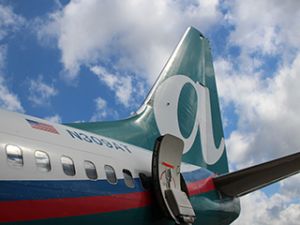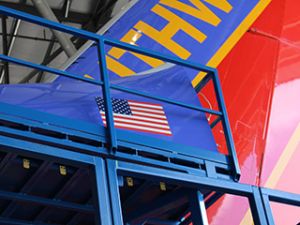On June 14 each year we recognize Flag Day, which commemorates the adoption of the flag of the United States as approved by the second Continental Congress in 1777. And today, a standard fixture on the 603 dorsal fins across our fleet is a two-foot, high-speed decal with 50 stars and 13 stripes.
Even though we have always been a Company of proud Americans, Southwest's Old Glory is a relatively recent addition to our standard livery.
Various policies and requirements dictate that aircraft operating internationally display the flag of their country of origin near their registration, or N-number in the case of United States-registered aircraft.

So, for many years legacy airlines with expansive service throughout the world included the American flag on all of their fleets, regardless if they flew internationally or not. As Southwest did not become an official “Flag Air Carrier” until 2013, there was no requirement for the stars and stripes to be displayed on our planes.

Shortly after the terrorist attacks of 2001, an outpouring of national pride was displayed just about everywhere. Flags were flown in front of millions of American’s homes, on their cars, and, perhaps the most memorable image, displayed on the battered exterior of the Pentagon by first responders in the hours after the unthinkable occurred.
In early December of that year, Herb received a letter from a fellow attorney who frequently flew Southwest between Baltimore and Tampa, asking why we did not have a flag anywhere on our aircraft. While he complimented our Pilot’s ties and thanked Herb for building a fantastic airline, he was very frustrated that Old Glory was nowhere to be found on our planes.

The Customer’s letter didn’t go unnoticed. After several Employees in the Executive Office researched the topic and presented their findings to Herb and Colleen, a response was written to the Customer along with a simple handwritten directive from Herb—do it. In less than a week after the decision was made to “fly” the flag on our planes, a Team of fewer than five Employees identified the best way to implement this program throughout our fleet of 360 aircraft at the time. To date, this is remembered by our Technical Operations Department as one of their proudest moments for the application of the flag decals so quickly across our expansive fleet.

You may have noticed on the First Officer’s (right) side of our planes the flag appears to be backwards. It is actually that way by design, just as you would see it on the right shoulder of our service members. The flag is displayed this way in order to appear as if it is blowing in the wind, as this is how you would view it on a flagpole from the same perspective. On what is arguably the most recognizable aircraft in the world, our Star-Spangled Banner also flies this way.
